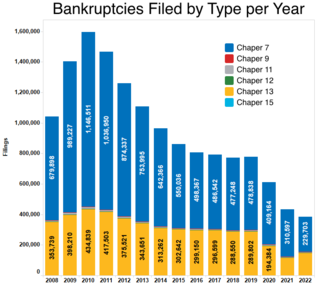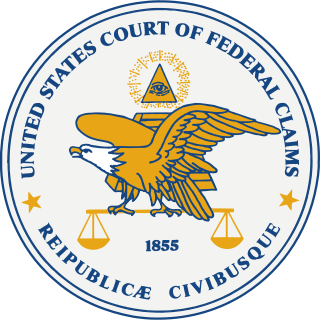
The United States courts of appeals are the intermediate appellate courts of the United States federal judiciary. The courts of appeals are divided into 13 "Circuits". Eleven of the circuits are numbered "First" through "Eleventh" and cover geographic areas of the United States and hear appeals from the U.S. district courts within their borders. The District of Columbia Circuit covers only Washington, DC. The Federal Circuit hears appeals from federal courts across the United States in cases involving certain specialized areas of law. The courts of appeals also hear appeals from some administrative agency decisions and rulemaking, with by far the largest share of these cases heard by the D.C. Circuit. Appeals from decisions of the courts of appeals can be taken to the U.S. Supreme Court.

The United States district courts are the trial courts of the U.S. federal judiciary. There is one district court for each federal judicial district, which each cover one U.S. state or, in some cases, a portion of a state. Each district court has at least one courthouse, and many districts have more than one. District courts' decisions are appealed to the U.S. court of appeals for the circuit in which they reside, except for certain specialized cases that are appealed to the U.S. Court of Appeals for the Federal Circuit or directly to the U.S. Supreme Court.
In the United States, federal judges are judges who serve on courts established under Article Three of the U.S. Constitution. They include the chief justice and associate justices of the U.S. Supreme Court, circuit judges of the U.S. Courts of Appeals, district judges of the U.S. District Courts, and judges of the U.S. Court of International Trade. These judges are often called "Article Three judges".

The United States District Court for the District of Montana is the United States District Court whose jurisdiction is the state of Montana. The court is located in Billings, Butte, Great Falls, Helena and Missoula.

The United States Court of Appeals for the Federal Circuit is a United States court of appeals that has special appellate jurisdiction over certain types of specialized cases in the U.S. federal court system. It has exclusive appellate jurisdiction over all U.S. federal cases involving patents, trademarks, government contracts, veterans' benefits, public safety officers' benefits, Federal employees' benefits, and various other categories. Unlike other federal courts, the Federal Circuit has no jurisdiction over cases involving criminal, bankruptcy, immigration, or U.S. state law.

In the United States, bankruptcy is largely governed by federal law, commonly referred to as the "Bankruptcy Code" ("Code"). The United States Constitution authorizes Congress to enact "uniform Laws on the subject of Bankruptcies throughout the United States". Congress has exercised this authority several times since 1801, including through adoption of the Bankruptcy Reform Act of 1978, as amended, codified in Title 11 of the United States Code and the Bankruptcy Abuse Prevention and Consumer Protection Act of 2005 (BAPCPA).

The Rooker–Feldman doctrine is a doctrine of civil procedure enunciated by the United States Supreme Court in two cases, Rooker v. Fidelity Trust Co., 263 U.S. 413 (1923) and District of Columbia Court of Appeals v. Feldman, 460 U.S. 462 (1983). The doctrine holds that lower United States federal courts—i.e., federal courts other than the Supreme Court—should not sit in direct review of state court decisions unless Congress has specifically authorized such relief. In short, federal courts below the Supreme Court must not become a court of appeals for state court decisions. The state court appellant has to find a state court remedy, or obtain relief from the U.S. Supreme Court.

The United States Tax Court is a federal trial court of record established by Congress under Article I of the U.S. Constitution, section 8 of which provides that the Congress has the power to "constitute Tribunals inferior to the supreme Court". The Tax Court specializes in adjudicating disputes over federal income tax, generally prior to the time at which formal tax assessments are made by the Internal Revenue Service.
The judiciary of Australia comprises judges who sit in federal courts and courts of the States and Territories of Australia. The High Court of Australia sits at the apex of the Australian court hierarchy as the ultimate court of appeal on matters of both federal and State law.

The United States Court of Federal Claims is a United States federal court that hears monetary claims against the U.S. government. It was established by statute in 1982 as the United States Claims Court, and took its current name in 1992. The court is the successor to trial division of the United States Court of Claims, which was established in 1855.
The United States territorial courts are tribunals established in territories of the United States by the United States Congress, pursuant to its power under Article Four of the United States Constitution, the Territorial Clause. Most United States territorial courts are defunct because the territories under their jurisdiction have become states or been retroceded.
Northern Pipeline Construction Company v. Marathon Pipe Line Company, 458 U.S. 50 (1982), is a United States Supreme Court case in which the Court held that Article III jurisdiction could not be conferred on non-Article III courts.
The Federal Rules of Bankruptcy Procedure are a set of rules promulgated by the Supreme Court of the United States under the Rules Enabling Act, directing procedures in the United States bankruptcy courts. They are the bankruptcy law counterpart to the Federal Rules of Civil Procedure.
A Bankruptcy Appellate Panel is authorized by 28 U.S.C. § 158(b) to hear, with the consent of all parties, appeals from the decisions of the United States bankruptcy courts in their district that otherwise would be heard by district courts, but only in those districts in which the district judges authorize appeals to BAPs. BAPs typically sit as three-judge panels composed of bankruptcy judges appointed from the circuit's districts, with the restriction that no judge may participate in an appeal arising from that judge's own district.

In United States federal courts, magistrate judges are judges appointed to assist U.S. district court judges in the performance of their duties. Magistrate judges generally oversee first appearances of criminal defendants, set bail, and conduct other administrative duties. The position of "magistrate judge" or "magistrate" also exists in some unrelated state courts.
A Referee in Bankruptcy or Bankruptcy Referee was a federal official with quasi-judicial powers, appointed by a United States district court to administer bankruptcy proceedings, prior to 1979. The office was first created by the Bankruptcy Act of 1898, and was abolished by the Bankruptcy Reform Act of 1978, which created separate United States bankruptcy courts with permanently assigned judges.
The history of bankruptcy law in the United States refers primarily to a series of acts of Congress regarding the nature of bankruptcy. As the legal regime for bankruptcy in the United States developed, it moved from a system which viewed bankruptcy as a quasi-criminal act, to one focused on solving and repaying debts for people and businesses suffering heavy losses.
Stern v. Marshall, 564 U.S. 462 (2011), was a United States Supreme Court case in which the Court held that a bankruptcy court, as a non-Article III court lacked constitutional authority under Article III of the United States Constitution to enter a final judgment on a state law counterclaim that is not resolved in the process of ruling on a creditor's proof of claim, even though Congress purported to grant such statutory authority under 28 U.S.C. § 157(b)2(C). The case drew an unusual amount of interest because the petitioner was the estate of former Playboy Playmate and celebrity Anna Nicole Smith. Smith died in 2007, before the Court decided the case, which her estate lost.

A certificate of division was a source of appellate jurisdiction from the circuit courts to the Supreme Court of the United States from 1802 to 1911. Created by the Judiciary Act of 1802, the certification procedure was available only where the circuit court sat with a full panel of two: both the resident district judge and the circuit-riding Supreme Court justice. As Chief Justice John Marshall wrote, he did not have "the privilege of dividing the court when alone."
Connecticut National Bank v. Germain, 503 U.S. 249 (1992), was a case in which the Supreme Court of the United States held that an interlocutory order of a district court, sitting as an appellate court in a bankruptcy case, is in turn reviewable by the court of appeals when authorized under 28 U.S.C. § 1292. Although the Justices were unanimous in deciding the specific statutory interpretation issue concerning bankruptcy appeals that the case presented, they disagreed on the extent to which it was appropriate to refer to the legislative history of the statute in resolving the case.








